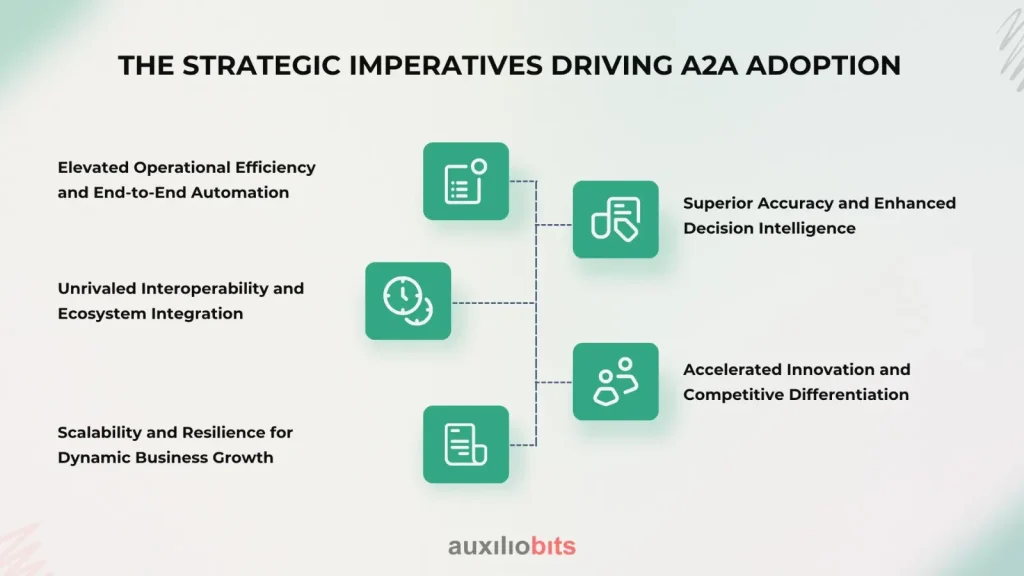
Key Takeaways
- A2A Enables True Collaborative Intelligence. Unlike traditional automation, the Agent-to-Agent (A2A) protocol empowers intelligent agents to autonomously discover, communicate, and coordinate—mirroring how real teams operate in business environments.
- From Siloed Processes to Seamless Value Chains. A2A eliminates the fragmented gaps in automation by creating a network of interoperable agents capable of executing complex, end-to-end workflows without manual intervention.
- Using standardized messaging (like FIPA ACL) and shared ontologies ensures agents from diverse systems can exchange meaningful, structured data, enabling scalable and flexible digital ecosystems.
- By abstracting communication and coordination to the agent layer, organizations achieve platform agnosticism, enabling rapid integration of new services, systems, and innovations.
- Adopting A2A and multi-agent systems moves businesses toward a self-organizing, intelligent enterprise model—unlocking resilience, agility, and competitive edge in an ever-evolving digital landscape.
In the current scenario, companies of all types are not just building software; they are creating an ecosystem where various systems, technologies, and tools must work together to ensure a smooth outcome. Even though automation and artificial intelligence are known to offer several advantages, these can only be enjoyed when smart systems can collaborate and interact with each other.
Now the question is, how will this happen? This is where the agent-to-agent protocol steps in, ensuring that all autonomous AI agents are connected to answer customer queries, share insights, and coordinate tasks.
Also read: Agent-to-Agent Protocols: How Google’s A2A is Shaping Future Automations?
Beyond Automation: The Power of Collaborative Intelligence via A2A
To understand why the agent-to-agent protocol is essential, we must consider the broader implications of automation. Agent-to-agent protocol introduces something more powerful—collaborative intelligence. Picture your organization as an orchestra, where each software agent is like a skilled musician playing a specific instrument (or handling a specific task). Without a shared language or coordination, they would play out of sync.
- Discover each other: “Who can provide this information?” or “Who can perform this service?”
- Negotiate and agree on tasks: “I need X, can you deliver by Y?” “Yes, I can, under condition Z.”
- Exchange rich, contextual information: Not just raw data, but data interpreted and understood within the agents’ shared knowledge domains.
- Coordinate complex workflows: Enabling sequential or parallel execution of tasks involving multiple specialized agents.
- Resolve conflicts or inconsistencies: Through predefined negotiation strategies.
The Strategic Imperatives Driving A2A Adoption
The shift towards A2A is not merely a technological trend; it’s a strategic imperative for businesses aiming to thrive in the 21st century. The tangible benefits ripple across the entire organization:

Elevated Operational Efficiency and End-to-End Automation:
Traditional automation often creates silos, automating one part of a process but leaving gaps that require human intervention. A2A eliminates these gaps by creating seamless, automated value chains. Consider a customer order: an order validation agent checks details, an inventory agent allocates stock, a logistics agent schedules shipping, a payment processing agent handles invoicing, and a customer notification agent provides updates – all communicating autonomously via A2A. This results in dramatically reduced cycle times, lower operational costs, and fewer errors across the entire process.
Unrivaled Interoperability and Ecosystem Integration:
The modern enterprise relies on a mosaic of legacy systems, cloud applications, and third-party services. Achieving seamless communication between these disparate systems has long been a monumental challenge. A2A offers a paradigm shift by abstracting communication to the agent level. As long as agents adhere to the A2A protocol (e.g., FIPA Agent Communication Language – ACL for message structure and semantics), they can communicate regardless of the underlying platform (Java, Python, .NET), database (SQL, NoSQL), or even vendor. This fosters true platform agnosticism and creates a genuinely composable enterprise, where new services and capabilities can be rapidly assembled from existing or new agents.
Scalability and Resilience for Dynamic Business Growth:
A well-architected A2A system is inherently distributed and decentralized. This architecture provides immense benefits for scalability. As your business demands grow, you can simply add more specialized agents to handle increased load or new functions without significant re-architecture of existing systems. Furthermore, the distributed nature enhances resilience; if one agent fails, others can often pick up its tasks or reroute requests, minimizing downtime and ensuring continuous operations, a critical factor in today’s always-on business environment.
Superior Accuracy and Enhanced Decision Intelligence:
Human intervention in repetitive, data-intensive tasks introduces opportunities for error. A2A-driven processes operate with machine precision. Agents, equipped with access to vast datasets and predefined logic, can execute tasks, analyze information, and even make micro-decisions with a level of accuracy and speed unattainable by humans. This leads to higher quality outcomes, improved data integrity, and a foundation for more reliable, data-driven strategic decisions.
Accelerated Innovation and Competitive Differentiation:
By offloading the execution and coordination of complex operational workflows to agents, your human workforce is freed to focus on strategic thinking, creativity, and high-value problem-solving. This directly fuels innovation. Businesses can experiment more rapidly with new business models, develop novel products and services, and respond to market shifts with unparalleled agility. A rapid development cycle for agent-based solutions becomes a powerful competitive differentiator.
A2A in Action: Transformative Use Cases
The practical applications of A2A are limited only by imagination, spanning virtually every industry:
Smart Manufacturing & Industry 4.0:
- Predictive Maintenance: A sensor agent on a machine detects anomalous vibrations. It sends an A2A message to a maintenance agent, which then communicates with a parts inventory agent to check availability, a scheduling agent to book technician time, and a production planning agent to adjust output – all autonomously preventing costly breakdowns.
- Dynamic Production Optimization: Agents representing different production stages (e.g., cutting, assembly, quality control) communicate in real-time to balance workloads, re-route defective batches, and optimize throughput based on current demand and machine status.
Revolutionizing Healthcare Operations:
- Personalized Patient Pathways: A diagnosis agent communicates with a treatment planning agent (suggesting protocols), which then interacts with a pharmacy agent (for medication orders) and a scheduling agent (for follow-ups), creating a seamless, patient-centric journey.
- Emergency Response Coordination: In a crisis, an incident reporting agent disseminates information to first responder agents (police, ambulance), hospital resource agents, and logistics agents (for supplies), orchestrating a rapid and efficient response.
Next-Generation Financial Services:
- Automated Compliance & Risk Management: Agents can continuously monitor transactions for regulatory compliance, identify potential fraud patterns by communicating with identity verification agents and behavioral analytics agents, and automatically generate reports for auditors.
- Personalized Financial Advisory: A client profile agent interacts with a market data agent, a portfolio management agent, and a product recommendation agent to provide highly customized investment advice or loan options.
Intelligent Smart Cities & Urban Management:
- Traffic Flow Optimization: Traffic sensor agents communicate with traffic light control agents and public transport agents to dynamically adjust light timings and reroute buses to alleviate congestion.
- Waste Management: Waste bin sensor agents notify a collection scheduling agent, which then optimizes routes for waste collection vehicle agents, reducing fuel consumption and increasing efficiency.
Architecting for Success: Critical Implementation Facets
Implementing A2A is an architectural undertaking that demands careful consideration:
Adoption of Standardized Protocols (e.g., FIPA ACL):
This cannot be overstressed. While proprietary A2A solutions exist, true long-term value comes from embracing open standards like FIPA ACL. This ensures that your agents can interact with external agents (e.g., from partners or public services) and future-proofs your investment by allowing for vendor agnosticism.
Robust Security and Trust Mechanisms:
In a multi-agent ecosystem, the attack surface expands. Implement zero-trust principles, secure communication channels (e.g., mTLS), strong authentication (agent identities), authorization mechanisms (what an agent can do), and immutable logging (for auditing) to build a truly secure and auditable environment. The ability to verify the “trustworthiness” of an agent before interaction is paramount.
Lifecycle Management and Orchestration Frameworks:
Agents are not static; they need to be deployed, monitored, updated, and potentially retired. A robust agent orchestration platform is essential. This platform should provide capabilities for:
- Agent registration and discovery.
- Runtime monitoring and health checks.
- Logging and auditing of inter-agent communications.
- Deployment and versioning of agents.
- Handling agent failures and recovery strategies.
Semantic Interoperability and Ontology Management:
Beyond just the syntax of messages, agents need to understand the meaning of the information they exchange. This requires shared ontologies – formal representations of knowledge in a domain. For instance, if one agent sends “temperature: 25C” and another expects “temperature: 77F,” the ontology can provide the conversion or common understanding.
Human-Agent Collaboration Frameworks:
While A2A aims for autonomy, human oversight and intervention will always be crucial. Design interfaces and protocols for human-agent teaming, allowing humans to monitor agent activities, intervene when necessary, train agents with new knowledge, and review complex decisions made by the agent network.
The A2A Protocol: Architecting the Autonomous Enterprise
The A2A protocol is more than a technical specification; it’s a blueprint for the autonomous enterprise. By enabling sophisticated, self-organizing networks of intelligent agents, businesses can move beyond mere automation to achieve a level of operational fluidity, responsiveness, and innovation previously unattainable. The journey towards a truly multi-agent business environment, orchestrated by the A2A protocol, is not just an efficiency play; it’s a fundamental reimagining of organizational intelligence and a decisive step towards shaping the future of business. Embrace this paradigm shift, and unlock the true symphony of your digital workforce.
The Final Thoughts
The A2A protocol is not merely an incremental technological advancement; it represents a fundamental paradigm shift towards a more autonomous, intelligent, and remarkably agile business future. By empowering software agents to communicate, collaborate, and make decisions in a distributed and self-organizing manner, organizations can unlock unprecedented levels of efficiency, innovation, and strategic advantage. Embracing the power of multi-agent systems and the A2A protocol isn’t just about adopting new technology; it’s about fundamentally rethinking how work gets done and positioning your enterprise at the forefront of the next wave of digital transformation. The future isn’t just automated; it’s intelligently interconnected and collaboratively driven by your digital workforce.








